Next Meeting - "Rhododendron Show and Tell" Our Chapter Share Session
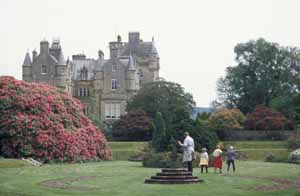 Our next meeting will be held at the National Arboretum Administration Building on
Sunday afternoon, January 19th, 2003, from 1:00 - 4:00 PM. For our program, we are
having a "Show and Tell" session where we asking our members to share a few words and
pictures with the rest of us. If you took a trip such as Don Hyatt did to see
castles and rhododendrons in Scotland last May (pictured to the right), or had some
special plant bloom this year, or you can show us pictures of your own garden or a
rhododendron landscape you visited, step up to the podium and tell us all about it.
Naturally, those who took our chapter field trip to Roan Mountain (pictured below) and
the Smokies last June should have lots of pictures and anecdotes to share, but we are
anxious to hear from all of our members. We encourage you to share your experiences,
so please bring along 5 to10 slides and be part of our program.
Our next meeting will be held at the National Arboretum Administration Building on
Sunday afternoon, January 19th, 2003, from 1:00 - 4:00 PM. For our program, we are
having a "Show and Tell" session where we asking our members to share a few words and
pictures with the rest of us. If you took a trip such as Don Hyatt did to see
castles and rhododendrons in Scotland last May (pictured to the right), or had some
special plant bloom this year, or you can show us pictures of your own garden or a
rhododendron landscape you visited, step up to the podium and tell us all about it.
Naturally, those who took our chapter field trip to Roan Mountain (pictured below) and
the Smokies last June should have lots of pictures and anecdotes to share, but we are
anxious to hear from all of our members. We encourage you to share your experiences,
so please bring along 5 to10 slides and be part of our program.
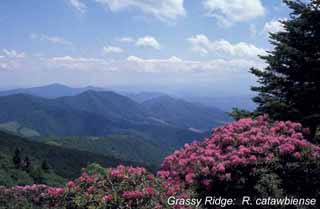
Seed Planting Demonstration: A second part of our program will be a demonstration of seed sowing . We will plant some left over seed from last year's exchange and we can transplant a few seedlings from some of Don Hyatt's excesses. Maybe you'll take home a future award winner or decide to buy more seeds in this year's exchange. Check out the seed list later in this issue.
Refreshment Duty: People whose last names end in I through P, please bring a goodie for the dessert table.
|
Don Voss Receives Bronze Medal
At our fall banquet, we were very pleased to be able to award Don Voss with our chapter's highest award, the Bronze Medal of the American Rhododendron Society. We have really appreciated Don's expertise and guidance over the years. He is an azalea expert, prolific author, super flower show judge, our resident authority on anything related to color, and much more. Congratulations, Don!
Rooting Cuttings During in the Winter Months by Don Hyatt
Winter's ice and snow can often lead to broken branches on your rhododendrons
and azaleas. Don't despair, those branches can usually be rooted with relative ease
during the winter months, even if they are severely desiccated after lying on the
ground for many weeks. Since the branch was a total loss anyway, why not try rooting
those cuttings? You don't have much to lose.
To check the viability of cutting material, I make a fresh cut at the base of the stem, put the end in water, and cover the top with a clear plastic bag to increase humidity. If the leaves plump up in a day or two, the cuttings will usually root too. You'll be amazed at how dead and dried up twigs revive!
I make short cuttings, less than two inches long. I wound each side of the stem to expose the cambium and also remove any flower buds. I dip the end of the cutting in a rooting hormone such as Rootone or Dip 'N Grow and insert the bottom inch into a container filled with my rooting medium, equal parts peat, sand, and perlite. The medium should be moist but not wet since excess moisture is the leading cause of cutting failure due to rotting. If possible, I briefly move containers outside and spray with an insecticide / fungicide mixture, and allow leaves to dry before bringing them back in the house. This reduces potential insect and disease problems. Finally, I enclose containers in clear plastic bags to create a mini-greenhouse and place the containers under fluorescent lights with my seedlings.
Cuttings usually break dormancy and begin to grow in a month or two, and by that time they are usually starting to form new roots as well. I do check the containers regularly to remove any leaves that turn brown or cuttings that might rot, but these mini-greenhouses should require no water or other care until ready to transplant in the spring. Another plus, cuttings rooted during the winter months are often large enough by the next fall to make it through their first winter without cold frame protection.
Making a Rhododendron Cross by Don Hyatt
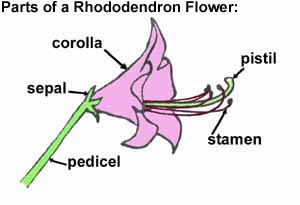 The number of offerings in this year's seed exchange is down slightly from last year, but there are a number of exciting things to tempt almost every grower. We do have lots of open pollinated seed where the bees have done the hybridizing. In some cases, a plant might be crossed with itself which is how Trude Webster grew from Countess of Derby selfed for Harold Greer. It could be crossed with something else in the garden which is presumably how Caroline arrived among R. decorum seedlings for Joe Gable. Hand pollinated crosses where both parents are known are preferred by hibridizers, so I want to encourage our members to start making crosses of their own. That way, we can offer more hand pollinated crosses next year. I hope the following information helps you make your own rhododendron crosses.
The number of offerings in this year's seed exchange is down slightly from last year, but there are a number of exciting things to tempt almost every grower. We do have lots of open pollinated seed where the bees have done the hybridizing. In some cases, a plant might be crossed with itself which is how Trude Webster grew from Countess of Derby selfed for Harold Greer. It could be crossed with something else in the garden which is presumably how Caroline arrived among R. decorum seedlings for Joe Gable. Hand pollinated crosses where both parents are known are preferred by hibridizers, so I want to encourage our members to start making crosses of their own. That way, we can offer more hand pollinated crosses next year. I hope the following information helps you make your own rhododendron crosses.
A typical flower is composed of a number of basic parts. The petals are usually the most obvious since their color is usually what attracts us when we see flowers in bloom. With rhododendrons and azaleas, the petals are usually not separate but are fused together into a single funnel-like structure called the corolla. Where the corolla attaches to the stem, or pedicel, there are usually smaller green bracts called sepals. In hose-in-hose flowers, those sepals may actually have become a second corolla.
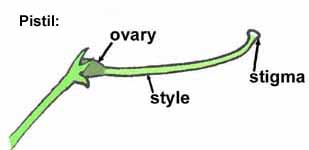 Protruding from the center of the flower are the important parts needed for hybridization. The female part of a rhododendron blossom is a solitary structure called the pistil. Typically, it is a little longer and thicker than the male parts of the flower which are the stamens. At the far end of the pistil is a sticky surface called the stigma. This is where pollen must be placed in order to make a cross. At the other end where the pistil adjoins the sepals is the ovary. This will later become the seed pod. The portion between the ovary and the stigma is called the style.
Protruding from the center of the flower are the important parts needed for hybridization. The female part of a rhododendron blossom is a solitary structure called the pistil. Typically, it is a little longer and thicker than the male parts of the flower which are the stamens. At the far end of the pistil is a sticky surface called the stigma. This is where pollen must be placed in order to make a cross. At the other end where the pistil adjoins the sepals is the ovary. This will later become the seed pod. The portion between the ovary and the stigma is called the style.
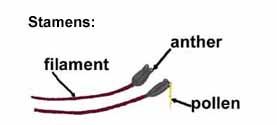 Most rhododendron and azaleas have from 5 to 10 stamens and each stamen has an obvious pollen sac at the end called the anther. With some rhododendrons like R. fortunei, the anthers contain so much pollen that it drools from the holes at the end and hangs in long strands. Pollen seems to exude from the anthers more readily when the stamens are jostled or twirled as when visited by a bee. With other rhododendrons, the pollen is not easily accessed and sometimes the anthers must be cut open to get to the grains. I prefer to use "promiscuous parents" with gobs of pollen.
Most rhododendron and azaleas have from 5 to 10 stamens and each stamen has an obvious pollen sac at the end called the anther. With some rhododendrons like R. fortunei, the anthers contain so much pollen that it drools from the holes at the end and hangs in long strands. Pollen seems to exude from the anthers more readily when the stamens are jostled or twirled as when visited by a bee. With other rhododendrons, the pollen is not easily accessed and sometimes the anthers must be cut open to get to the grains. I prefer to use "promiscuous parents" with gobs of pollen.
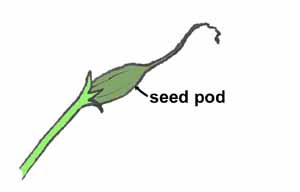 The process of making a cross is rather simple. Just remove a couple of stamens from one flower and dab the pollen on the stigma of another blossom. Pollination is done! Within a day or two, the minute pollen grains on the stigma will germinate and send tiny tubes down the style to fertilize the undeveloped seeds in the ovary. By mid summer, the ovary should be much larger than it was when the flower was first pollinated, and the rest of the pistil will have withered and turned brown. As the seed pod dries out in late fall, it will split open to release the tiny seeds inside. At that time, the seeds can be planted but they can also be saved for future years. Seed viability does diminish with time, so if they are not planted during that first year, it is best to store them in a refrigerator in order to keep germination rates high.
The process of making a cross is rather simple. Just remove a couple of stamens from one flower and dab the pollen on the stigma of another blossom. Pollination is done! Within a day or two, the minute pollen grains on the stigma will germinate and send tiny tubes down the style to fertilize the undeveloped seeds in the ovary. By mid summer, the ovary should be much larger than it was when the flower was first pollinated, and the rest of the pistil will have withered and turned brown. As the seed pod dries out in late fall, it will split open to release the tiny seeds inside. At that time, the seeds can be planted but they can also be saved for future years. Seed viability does diminish with time, so if they are not planted during that first year, it is best to store them in a refrigerator in order to keep germination rates high.
There are some procedures that hybridizers use to ensure a "pure" cross with no possibility of contamination. When someone has a hybridizing goal in mind, why waste time raising stray seedlings that don't meet goals of the desired cross? However, hybridizers will admit that some of the best things often come from those chance seedlings. Personally, I like to force budded plants in my greenhouse so I can make crosses in late winter where there will not be a problem with rain, wind, or bees bringing in stray pollen from another flower. When making crosses outside, it is best to remove the corolla and stamens from unopened buds of the proposed seed parent prior to making a cross. That way, insects will not be attracted to the flower and without stamens there will be less chance of self pollination. Because the flower parts were removed in the bud stage it is not easy to tell when the flower is "open" and ready for pollination. The stigma should be watched carefully to see when it becomes moist and sticky since that is when it is ready to accept pollen. After pollen is applied, some people protect the stigma with a small piece of aluminum foil crimped over the tip or even a plastic bag covering the entire flower truss. That extra precaution is usually not required if there was ample pollen.
I usually try to pollinate at least half the flowers in rhododendron truss. That way if I see big seed pods develop on flowers where I made a cross and only undeveloped ovaries elsewhere, I feel certain the cross is good. Always label the cross so it is easy to find later and there is no confusion as to the parentage. By convention, the seed parent is listed first and the pollen parent is listed second.
As I walk in my garden or admire flowers in the truss show, I am always imagining potential crosses. Reality is far different, though. Sometimes, a desired goal can take many years to achieve such as Joe Gable's 16-year quest to produce the hardy white azalea, Rose Greeley. Most hose-in-hose azaleas have structural infertility and won't set seed so they can only be used as a pollen source. Other plants like Scintillation or Cecile do not have viable pollen so they can only be used as a seed parent. Also, undesired traits may be dominant and good ones recessive, so a first generation cross may not show desired results. Hybridizing reminds me of an amusing anecdote where a beautiful British actress once proposed marriage to George Bernard Shaw saying how perfect their children would be if they had her looks and his brains. Shaw declined her offer noting there was a strong chance their children could have his looks and her brains, and that was too great a risk for humanity. Just like playing cards, the more seedlings you raise, the better the chances for a winning hand. Realize of course that the best plants from a cross will be seedlings you gave away or hybrids made by bees. It's Murphy's Law again!
Raising Rhododendrons and Azaleas from Seed
Raising rhododendrons and azaleas from seed is easy. First, fill a pot or suitable container with some standard rhododendron potting mixture such as equal parts peat moss, sand, and perlite. The medium should be moist but not wet. Firm the surface lightly and sprinkle the seeds over the top. Place the pot inside a clear plastic bag to make a mini-greenhouse, and put the container under some fluorescent lights or in a bright window that doesn't get too much direct sun. Seed will germinate in 3 to 4 weeks and should require no additional care until spring when seedlings can be transplanted into individual pots. Rhododendrons can bloom in 3 to 4 years from seed, and azaleas bloom even sooner.
Seed Exchange: Next Generation Gable Hybrids
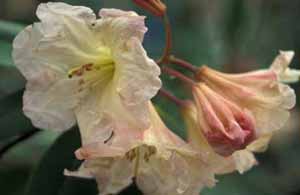 Many local hybridizers are trying to produce luscious yellow, orange, and
apricot rhododendrons that will also be hardy in our area. Since few hybrids on the
market already fill that bill, some growers are building on the hardy Gable
rhododendrons to produce those next generation hybrids.
Many local hybridizers are trying to produce luscious yellow, orange, and
apricot rhododendrons that will also be hardy in our area. Since few hybrids on the
market already fill that bill, some growers are building on the hardy Gable
rhododendrons to produce those next generation hybrids.
Joe Gable left us a wonderful legacy to work with including such beauties
as Mount Siga and Kulu that he raised from R. vernicosum seed carrying the number
18139 collected by Joseph Rock in his 1929 expedition. The peach pink Dr. Rock
came from a cross of R. houlstonii with one of those plants, but Gable also
crossed a cream selection of R. fortunei with R. vernicosum 18139 to produce the
salmon yellow Mary Garrison pictured above to the right.
Mary Garrison is a proven parent, producing some outstanding plants including one
of my favorite Jane Goodrich hybrids, (Catfortcampy #2 x Mary Garrison),
a striking orange and pink blend pictured below to the left.
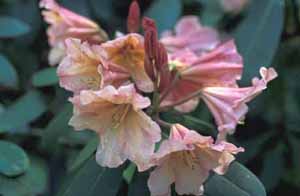
If you like those artistic color tones, check out the crosses and open pollinated selections in this years seed exchange. Many are familiar with the Beaudry's yellow and apricot seedlings from a cross of (Brookville x Mary Garrison) with (Kehr's yellow 9-59 x Dexter's Tan). Maybe they will name that lovely yellow that swept awards in our truss show one year. Don Hyatt bloomed some seedlings of (Hawk 'Crest' x Idealist) and he then crossed one of them with Wheatley to produce a nice pink with a yellow throat. He has now crossed that plant with Gable's Mary Belle.
|
Potomac Valley Chapter Seed Exchange Listing for 2003
The following link will show seeds that are offered in this year's seed exchange to the members of
the Potomac Valley Chapter ARS. Some seeds may be in short supply, so please list alternates
in your seed order. Packets cost $0.50 each, and members may request only one packet
per variety. Send a check made out to Potomac Valley Chapter ARS to Don Hyatt by February
5, 2003. Seeds will be divided among those who have requested the selection shortly after
that date.
|